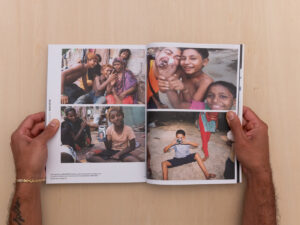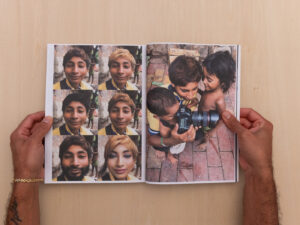Bob and Fam for Another Man
- Information
What About Bob? by Nick Sethi
Published in Another Man Volume II Issue I, 2024
Interview by Ted Stansfield
“This project began in India in 2011. I was photographing some elephants on the side of the highway and this kid kept running into the frame, posing and flexing and wanting to be photographed. This kid – who I came to call Bob – introduced me to his family, who were living under a highway overpass at the time, and we started hanging out and using cameras in ways I’d never experienced before – as a tether or vehicle for empathetic connection.
“Eventually Bob went missing, which I thought would be the end of the project. But in his absence, his family and I made a photo album about him. And that’s something that keeps coming into my work: this idea of absence as a generative process.
“He ended up coming back years later, which was surreal – but it’s always surreal with them. I’ll fly to Delhi to see them and they won’t be in the same place so I have to search for them, and then I’ll find them and they’ll just be like, ‘Oh, hey!’ When Bob came back it was so matter of fact, he was so nonchalant.
“One time, I showed up and Bob had drawn versions of my tattoos on himself. I have a tiny rose on my hand and he had a tiny star in the same place, along with a matching cobra. It was so strange because they had no idea I’d be there. There are such strong tethers between us, which aren’t about language or anything – they’re metaphysical. I can feel them from other countries – even me going to India, I went for no particular reason. Something pulled me.
“I think about this project almost every day, and it affects everything that I do, photographically and otherwise. It has no real edges or corners. It started with playing around and handing my camera to young kids and having them blow through rolls of film in ten seconds. But these things that I would have never thought of, or that would have seemed counterproductive, have become my new school of thought.
“It’s helped me think of photography as a mindfulness or therapeutic practice – trying and failing and evolving. I’ve worked with Bob and his family for over a decade now and so much has changed: family members have passed away or run away; four babies have been born; I’ve grown up, I’ve watched them grow up; I’ve started a fashion photography career, very much because of this project. And yet it’s not a project, it’s a relationship.
“Having a million different perspectives on something is very specific to this project because it’s about their view of each other as much as mine. I want it to be equal. And the camera itself is photographed a lot – it’s that tether and vehicle for connection I mentioned earlier. There’s one picture of Bob taking a picture of his niece’s face and they’re so close. I learned so much from that. I started shooting on wider lenses because it’s amazing to be so close; to block out the rest and for it to be about just us. If I can whisper to you, we’re close, you know?”






